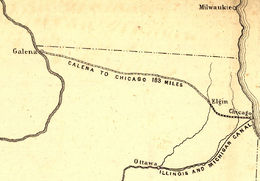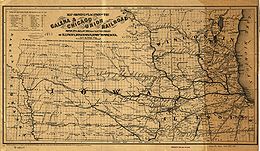This article includes a
list of references,
related reading, or
external links, but its sources remain unclear because it lacks
inline citations. (August 2021) |
 Original plan from Chicago to Galena | |
| Overview | |
|---|---|
| Locale | northern Illinois |
| Dates of operation | 1836 (chartered); 1848 (in service)–1864 |
| Successor | Chicago and North Western |
| Technical | |
| Track gauge | 4 ft 8+1⁄2 in (1,435 mm) standard gauge |

The Galena and Chicago Union Railroad (G&CU) was a railroad running west from Chicago to Freeport, Illinois, never reaching Galena, Illinois. A later route went to Clinton, Iowa. Incorporated in 1836, the G&CU became the first railroad built out from Chicago.
History
The first railroad constructed out of Chicago, the Galena and Chicago Union, was chartered on January 16, 1836, to connect Chicago with the lead mines at Galena, a year before the city of Chicago was incorporated. " The Pioneer," the first locomotive on the road, arrived at Chicago on October 10, 1848, nearly thirteen years after the charter was granted. In 1850, the Galena and Chicago Union Railroad was completed as far as Elgin. The railroad and the Illinois and Michigan Canal were vital in the development of Chicago, and the population of the city tripled in the six years after the opening of the canal. Eventually other railroads were built and Chicago became the largest railroad center in the world.
Meanwhile the G&CU Railroad was envisioning a grand design for a road from Chicago across the Mississippi River and across Iowa to connect with Thomas Clark Durant's Union Pacific in Omaha at Council Bluffs, Iowa. To do this they needed to get control of the Iowa railroads in Clinton. The Chicago Iowa & Nebraska had built from Clinton to Cedar Rapids before running out of money. New funding and vigor were aquired when a John Insley Blair group formed the Cedar Rapids and Missouri River Railroad planning to connect Cedar Rapids with Council Bluffs.
In the spring of 1861 the Galena planted a young civil engineer from Northfield Vermont, Isaac B Howe, to assume control of construction on the Clinton roads when the previous engineer and superintendent, Col. Milo Smith, left to lead the 26th Iowa Infantry Regiment to war against the Confederate rebellion. Howe was previously Roadmaster on the Vermont Central/ Canada road.
At the same time two other railroad friends from Northfield, Dr. Edward H Williams and John C. Gault, were engaged by the Galena to build as rapidly as the war would allow toward Fulton on the Illinois side of the Mississippi. There a bridge was under construction to an island in the river opposite Clinton where the CI&N railroad had begun their road.
In July 1862 it all came together as the G&CU leased both the CR&MR as well as the CI&N lines in perpetuity. The 1862 map by G. Woolworth Colton shown here lays out the various lines in operation at that time. [1] The G&CU was in turn consolidated with the Chicago and North Western Railway on June 2, 1864, with I B Howe as superintendent of the newly formed Iowa division and Dr. E H Williams and John Gault superintending a newly formed Galena division in Illinois. The former Asst. Supt. of the Chicago, St Anthony & Fon du Lac railway, George L. Dunlap, was now the Gen. Supt. for the entire consolidated railroad. The line to Council Bluffs was completed in January 1867, the first railroad to connect with the Union Pacific in Omaha and the first transcontinental railroad. The lease was formally turned into a sale in 1884.
The C&NW merged with the Union Pacific Railroad over a century later in 1996.
Today, the G&CU's main line between Chicago and West Chicago is a busy commuter service, jointly operated by Union Pacific and Metra as the Union Pacific / West Line. The remainder of the line from West Chicago to Rockford is still in service carrying only freight (though Amtrak service to Rockford has been proposed and planned) with local industrial spurs in Rockford and Loves Park. The route between Rockford and Freeport is abandoned, and is being converted into a rail trail.
Construction
The railroad was constructed starting in March 1848, and was completed to Freeport in 1853. The first westbound train out of Chicago departed on October 25, 1848, pulled by a used Baldwin-built locomotive named Pioneer. [2] [3] When construction reached the Fox River at Elgin in 1850 passengers going farther west could transfer to the stagecoach lines. The railroad extended to Rockford by 1851 and ended construction at Freeport in 1853. The Illinois Central Railroad, using the G&CU construction crew, completed the Freeport to Galena route in 1854 following the stage route already established by Frink, Walker and Company.
Depots
Stations between Chicago and Freeport included the following:
- Chicago, Illinois (1848. Depot at Kinzie and Canal Streets north of the Chicago River was converted to an employees' reading room 1853. Second depot at Kinzie and Wells Streets burned in 1871. The Merchandise Mart now occupies the site)
- Garfield Park (1848. formerly Central Park)
- Oak Park, Illinois (1848. formerly Oak Ridge, Cicero)
- Melrose Park, Illinois (1849) formerly Melrose
- Berkeley, Illinois (1849. Formerly Proviso)
- Elmhurst, Illinois (1849. Formerly Cottage Hill)
- Lombard, Illinois (1849. Babcock's Grove)
- Glen Ellyn, Illinois (1849. Formerly Danby)
- Wheaton, Illinois (1849)
- Winfield, Illinois (1849–1854. Hedges Station)
- West Chicago, Illinois (1849. Turner Junction. Hotel and roundhouse 1853)
- Wayne, Illinois (1850)
- South Elgin, Illinois (1850. formerly Clintonville)
- Elgin, Illinois (1850)
- Gilberts, Illinois (1855. Gilbert's Station)
- Huntley, Illinois (1851)
- Union, Illinois (1851)
- Marengo, Illinois (1851)
- Garden Prairie, Illinois (1853)
- Belvidere, Illinois (1851)
- Cherry Valley, Illinois (1853)
- Rockford, Illinois (1851)
- Winnebago, Illinois (1853)
- Pecatonica, Illinois (1853)
- Nevada, Ridott Township, Stephenson County, Illinois (1853. Depot was moved to Ridott 10 July 1860. Nevada no longer exists)
- Ridott, Illinois (1860)
- Freeport, Illinois (1853)
From West Chicago to Clinton:
- La Fox, Illinois (1859)
- Elburn, Illinois (1854, formerly Blackberry)
- Maple Park, Illinois (1854, formerly Lodi)
- Cortland, Illinois (1854)
- DeKalb, Illinois (1854)
- Malta, Illinois (1855, formerly Milton)
- Creston, Illinois (1855, Formerly Dement)
- Rochelle, Illinois (1855, formerly Hang Town)
- Flagg, Illinois(1856)
- Ashton, Illinois (1855, formerly Ogle)
- Franklin Grove, Illinois (1855)
- Nachusa, Illinois (1855)
- Dixon, Illinois (1855)
- Nelson, Illinois (1858)
- Sterling, Illinois (1855)
- Galt, Illinois (1857)
- Agnew, Illinois (1860)
- Como, Illinois (1855. Depot was moved to Agnew in 1860)
- Round Grove, Illinois (1855)
- Lyndon, Illinois (1857)
- Morrison, Illinois (1855)
- Union Grove, Illinois (1859)
- Fulton, Illinois (1855. Line was moved to East Clinton after C&NW takeover)
- Clinton, Iowa (1855)
Crystal Lake Branch
- East Dundee, Illinois (1854)
- Algonquin, Illinois (1855)
- Crystal Lake, Illinois (1855)
Aurora Branch
- Batavia, Illinois (1872)
- Aurora, Illinois (1888)
St. Charles Branch
- Geneva, Illinois (1854)
- St. Charles, Illinois (1871)
References
- ^ "Map Showing the Location of the Galena & Chicago Union Railroad with its Branches & Connections in Illinois, Wisconsin, Iowa and Minnesota. Engraved & Printed by G. Woolworth Colton, No. 18 Beekman St., N.Y." 1862. Described in Robert A. Holland (2005) Chicago in Maps 1612 to 2002.. New York: Rizzoli International Publications. pp. 74–75. ISBN 0-8478-2743-7 Original map is located in the Library of Congress, Washington D.C.
- ^ Rivanna Chapter, National Railway Historical Society (2005), This Month in Railroad History - October. Retrieved October 25, 2005.
- ^ Chicago Historical Society, History Lab Collections - Riding the Rails Archived 2006-05-27 at the Wayback Machine. Retrieved October 25, 2005.
Sources
- Cronon, William (1992). Nature's metropolis: Chicago and the great west (reprint ed.). W. W. Norton & Company. ISBN 0-393-30873-1. examines the economic effects of the railroad (among other things).
- A Chronological History of Chicago: 1673- Compiled by Chicago Municipal Reference Library, City of Chicago, updated by Municipal Reference Collection, Chicago Public Library
- The Northern Counties Gazetteer and Directory for 1855–6: A Complete and Perfect Guide to Northern Illinois Containing a Concise Description of the Cities, Towns & Principal Villages... (1855). 189 Lake Street, Chicago. Reprinted on demand by Pranava Books, India. August 2019.
- Predecessors of the Chicago and North Western Transportation Company
- Defunct Illinois railroads
- Defunct Iowa railroads
- Railroads in the Chicago metropolitan area
- Railway companies established in 1836
- Railway companies disestablished in 1864
- American companies established in 1836
- 1836 establishments in Illinois
- American companies disestablished in 1864